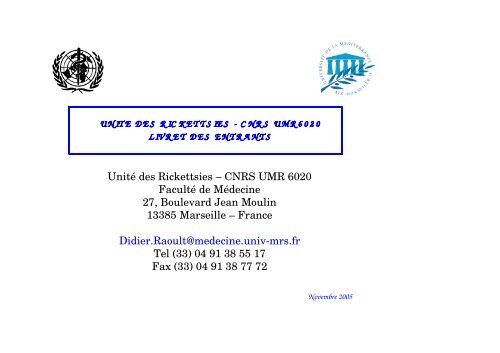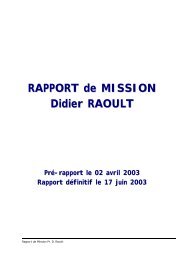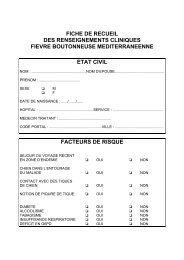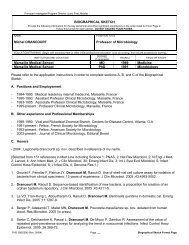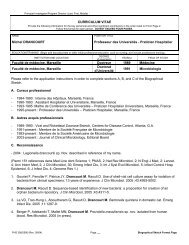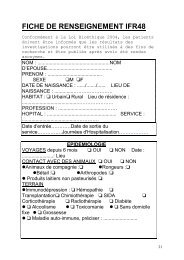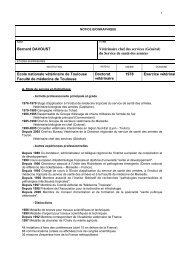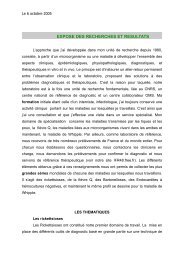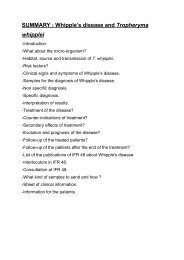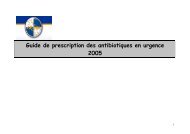Unité des Rickettsies - Marseille, Maladies Infectieuses - Université ...
Unité des Rickettsies - Marseille, Maladies Infectieuses - Université ...
Unité des Rickettsies - Marseille, Maladies Infectieuses - Université ...
Create successful ePaper yourself
Turn your PDF publications into a flip-book with our unique Google optimized e-Paper software.
U N IT E D E S R IC K E T T S IE S - C N R S U M R 6 0 2 0<br />
L IV R E T D E S E N T R A N T S<br />
Unité <strong>des</strong> <strong>Rickettsies</strong> – CNRS UMR 6020<br />
Faculté de Médecine<br />
27, Boulevard Jean Moulin<br />
13385 <strong>Marseille</strong> – France<br />
Didier.Raoult@medecine.univ-mrs.fr<br />
Tel (33) 04 91 38 55 17<br />
Fax (33) 04 91 38 77 72<br />
Novembre 2005
Le Professeur Didier RAOULT et toute son équipe vous<br />
souhaitent la bienvenue à l’Unité <strong>des</strong> <strong>Rickettsies</strong>.<br />
Vous trouverez dans ce fascicule toutes les<br />
informations relatives au fonctionnement de l’Unité.<br />
Dans l’intérêt de tous, nous vous remercions de<br />
respecter les consignes.<br />
Professor Didier RAOULT and his staff welcome you to<br />
the Unité <strong>des</strong> <strong>Rickettsies</strong>. You will find enclosed all<br />
practical informations concerning our laboratory. We<br />
thank you for respecting these instructions
O R G A N IG R A M M E D E L ’U N IT E /O R G A N IZ A T IO N C H A R T<br />
N U M E R O S D E T E L E P H O N E /P H O N E N U M B E R S<br />
E N C A S D ’ U R G E N C E<br />
IN C A S E O F U R G E N C Y 0 4 2 4 2<br />
Annuaire téléphonique interne<br />
Unité <strong>des</strong> <strong>Rickettsies</strong><br />
2ème ETAGE : 2nd floor<br />
SECRETARIAT 04 91 32 43 75 / 04 91 38 55 17 / Fax : 04 91 38 77 72<br />
BIBLIOTHEQUE 116 / 49 41<br />
BUREAU MD/JLM 113<br />
P3 120 / 4647<br />
LAVERIE 134<br />
SEROLOGIE - RECEPTION 114<br />
SEROLOGIE – CULTURE 120<br />
SEROLOGIE 126<br />
BUREAU MS/CC/FG 121<br />
BUREAU MEDECINS 122/123/124/125<br />
LABO BIOMOL – SEQUENCAGE 118<br />
LABO IMMUNO<br />
LABO WESTERN BLOT/ 2D 133<br />
LABO BACTERIO HORS P3 133<br />
BUREAU JB/PG/PP/PB/ 132<br />
BUREAU GG/EG/PR 4630<br />
BUREAU ETUDIANTS 4628/4629<br />
3ème ETAGE : 3rd floor<br />
BUREAU INGENIEURS 4625<br />
LABO MICROARRAYS 4625<br />
P3-NSB COMMUN 4611<br />
INODIAG 4640
R E G L E S D ’A C C E S A U L A B O R A T O IR E / R U L E S A B O U T T H E L A B O R A T O R Y A C C E S S<br />
1 - L'accès au laboratoire est limité pendant les heures ouvrables (du lundi au vendredi de 7h30 à 19<br />
heures) uniquement aux étudiants en possession d'une carte. Cette carte est strictement<br />
personnelle / The laboratory entry is restricted to authorized members and requires a specific and<br />
strictly personal badge entry<br />
2 - En dehors <strong>des</strong> heures ouvrables (après 19 heures et le week-end) chaque étudiant désirant<br />
venir au laboratoire doit demander l'avis de son responsable scientifique qui devra en référer au<br />
directeur du laboratoire /Besi<strong>des</strong> working days (after 7 p.m and durind the week-end), entry into the<br />
lab must requires approval of the supervisor and of Pr D. RAOULT)<br />
3 - Il est formellement interdit de faire venir au laboratoire en dehors <strong>des</strong> heures ouvrables toute<br />
personne non autorisée / Besi<strong>des</strong> working days it is strictly forbidden to introduce in the lab any<br />
person not allowed<br />
4 - Les cartes d'accès pour les étudiants auront une validité correspondant aux dates pendant<br />
lesquelles ils sont effectivement au laboratoire / Access badge will have an expiration date<br />
corresponding to the training course.<br />
5 - En cas de perte, l'étudiant doit le signaler immédiatement au secrétariat de l'Unité / Loss of the<br />
entry badge must be immediately reported to the secretariat.
P L A N D U L A B O R A T O IR E 2 è m e é ta g e<br />
M A P 2 n d flo o r<br />
MDrancourt<br />
JL Mège<br />
LABO BIOMOL – SEQUENCAGE<br />
LABO WESTERN BLOT/2D<br />
LABO BACTERIO HORS P3<br />
LABO IMMUNO<br />
BIBLIOTHEQUE<br />
S E C R E T A R IA T<br />
D.RAOULT<br />
Extractions<br />
ADN<br />
CHAMP PULSE<br />
SEROLOGIE<br />
Cuisine<br />
P. Gluschenkof P. Berger<br />
P. Parola<br />
J. Bayle<br />
B U R E A U<br />
M E D E C IN S<br />
P. Renesto<br />
E. Ghigo<br />
G. Grau<br />
LAVERIE<br />
P3<br />
S E R O L O G IE<br />
R E C E P T IO N<br />
B U R E A U<br />
E T U D IA N T S<br />
M. Suzan<br />
C. Capo<br />
F. Gouriet<br />
V. Combes
P L A N D U L A B O R A T O IR E 3 m e é ta g e<br />
M A P 3 r d flo o r<br />
B U R E A U IN G E N IE U R S<br />
Salle de<br />
réunion<br />
Terrasse<br />
Labo<br />
Labo<br />
Labo<br />
R E S T R U C T U R A T IO N<br />
IN P R O G R E S S<br />
LABO<br />
MICROARRAYS<br />
L A B O<br />
M IC R O A R R A Y S<br />
IN O D IA G
B A D G E D ’E N T R É E / E N T R Y C A R D<br />
R e s po ns a b le / P e rs o n in c ha rg e : C a th y C O R O N A<br />
L’accès à l’Unité est contrôlé par une carte magnétique qui vous sera délivrée par Cathy<br />
CORONA. La liste <strong>des</strong> pièces auxquelles vous aurez accès devra être validée par le Pr. D.<br />
RAOULT. Chaque ouverture de porte est enregistrée et l’historique peut être vérifié.<br />
Pour les week-ends, l’entrée dans le bâtiment se fait avec un autre badge.<br />
Laboratory entry is controlled by a magnetic card which will be delivered to you by Cathy<br />
CORONA. The list of rooms to which you will have access must to be validated by Pr. D.<br />
RAOULT. Each entrance is memorized and can be checked later.<br />
For week-ends, another card is required to enter into the building.<br />
HYGIENE ET SECURITE / HYGIENE AND SAFETY<br />
Responsable/ Person in charge : Bernadette GIUMELLI<br />
Tous les nouveaux entrants à l’Unité <strong>des</strong> <strong>Rickettsies</strong> doivent suivre et valider la<br />
formation Hygiène et Sécurité auprès de Bernadette GIUMELLI.<br />
Nous vous rappelons que l’accès au P3 est strictement réservé aux personnes<br />
ayant suivi une formation complémentaire appropriée.<br />
All new researchers at the Unité <strong>des</strong> <strong>Rickettsies</strong> must follow and validate the<br />
Hygiene and Safety formation with Bernadette GIUMELLI. We remind to you<br />
that P3 access is strictly reserved to the people having followed an adapted<br />
further training.<br />
En cas d’accident, le médecin référent est Philippe BROUQUI.<br />
In case of accident, please contact Philippe BROUQUI.<br />
Tél. 06 07 79 82 74
E T R A N G E R S / F O R E IG N S T U D E N T S<br />
R e s po ns a b le / P e rs o n in c ha rg e : André a s S TEIN<br />
Les étudiants et stagiaires étrangers et peuvent s'adresser<br />
à Andréas STEIN pour tout problème administratif.<br />
Francine SIMULA et Brigitte GUARNIERI peuvent<br />
également vous aider.<br />
The foreign students and trainees can ask for Andréas<br />
STEIN for any problem with administration. Francine<br />
SIMULA and Brigitte GUARNIERI can also help you.<br />
S C O L A R IT E IN S C R IP T IO N S / F O R E IG N S T U D E N T S<br />
Re s po ns a b le / Pe rs o n in c h a rg e : Je a n-Lo uis Mè g e<br />
Pour toute question concernant votre formation Master (première année, deuxième<br />
année, spécialité « <strong>Maladies</strong> Transmissibles et Pathologies Tropicales) et votre<br />
formation Doctorale vous pouvez vous adresser à Jean-Louis MEGE.<br />
Please contact Jean-Louis MEGE if you have some questions concerning your Master<br />
program (first year, second year, “Transmissible Diseases and Tropical Pathologies”)<br />
and your PhD program.
IN F O R M A T IQ U E / IN F O R M A T IC S<br />
R e s po ns a b le / P e rs o n in c ha rg e : Ro b e rt PIS TO RES I<br />
TOUTES LES INFORMATIONS IMPORTANTES SONT DIFFUSEES PAR VOIE<br />
ELECTRONIQUE.<br />
Vous pouvez vous adresser à Robert PISTORESI pour obtenir une adresse e-mail. Si vous avez<br />
déjà votre propre adresse que vous souhaitez conserver, merci de la communiquer au secrétariat.<br />
ALL IMPORTANT INFORMATIONS ARE DIFFUSED BY ELECTRONIC WAY. You can contact<br />
Robert PISTORESI to obtain an address e-mail. If you have already your own address which you<br />
wish to preserve, thank you to communicate it to the secretariat.<br />
B IB L IO G R A P H IE / B IB L IO G R A P H Y<br />
R e s po ns a b le / P e rs o n in c ha rg e : Is a b e lle C O MBE<br />
Si vous souhaiter consulter <strong>des</strong> revues ou ouvrages à la Bibliothèque Universitaire, il faut vous<br />
inscrire auprès d’Isabelle COMBE. Les documents empruntés sont photocopiés dans le laboratoire.<br />
If you to wish to consult reviews or works at the University Library, you should be registered by<br />
Isabelle COMBE. The borrowed documents will be photocopied in the laboratory.<br />
Vous pouvez également consulter les journaux scientifiques sur le WEB aux adresses suivantes :<br />
Scientific reviews can be consulted at following addresses :<br />
http://bu2.timone.univ-mrs.fr/ - Bibliothèque Universitaire, accès libre (free access).<br />
http://bibliovie.inist.fr<br />
- Site CNRS, accès réservé (reserved access)<br />
Nom d’utilisateur / User name SDVUMR6020<br />
Mot de passe / password BG9QEJNV<br />
Le logiciel de gestion de la bibliographie utilisé dans l’Unité est REFERENCE MANAGER. Si<br />
vous le souhaitez, Isabelle pourra vous initier à son utilisation.<br />
The software of management of the bibliography used in the Unité <strong>des</strong> <strong>Rickettsies</strong> is REFERENCE<br />
MANAGER. If you wish it, Isabelle will explain you how to use it.
REUNIONS DE TRAVAIL/ WORK MEETINGS<br />
CES REUNIONS SONT OBLIGATOIRES TOUS LES ETUDIANTS ET POST-DOCTORANTS.<br />
THESE MEETINGS ARE OBLIGATORY FOR ALL STUDENTS AND POST-DOC.<br />
WORK IN PROGRESS Responsable / Person in charge : Marie Benoit<br />
3 mercredis/mois à 14h30. 3 wednesdays/month at 2.30 PM<br />
Tous les étudiants doivent y présenter régulièrement leurs résultats. Les diapositives seront<br />
rédigées en anglais. En plus <strong>des</strong> présentations du travail en cours, les doctorants à partir de la deuxième<br />
année de Thèse doivent faire, une fois par an, le point complet sur l’état d’avancement de leurs travaux.<br />
All students will present their results regularly using sli<strong>des</strong> prepared in english. In addition to<br />
these brief presentations concerning the work in progress, from the second year of Thesis students must<br />
summarized one time/year all data obtained;<br />
SEANCES DE BIBLIOGRAPHIE Responsable / Person in charge : Nicolas Crapoulet<br />
En général le dernier mercredi de chaque mois à 14h30.<br />
Last wednesday of each month at 2.30 PM.<br />
Les doctorants, post-doctorants et seniors font un bref compte rendu <strong>des</strong> articles intéressants paru<br />
dans les journaux qu’ils sont chargés de suivre.<br />
Students and senior researchers make a short report of the most interesting papers<br />
published in the scientific journals that they have in charge.<br />
SEMINAIRES IFR. Responsable / Persons in charge : Eric Ghigo / Patricia Renesto<br />
Tous les vendredis de 12h45 à 13h45. Each Friday between 0.45 PM to 1.45 PM<br />
Tous les seconds vendredis du mois, le séminaire IFR est réservé aux doctorants de 3ème et 4ème<br />
année : 2 présentations sous forme de séminaire sont prévues.<br />
All second fridays of the month, IFR seminar is reserved for 2 presentations given by the 3rd and<br />
4th year thesis students.
CONSEILS DE LABORATOIRE/ LABORATORY COUNCILS<br />
Programmés 1 fois/mois. Présence OBLIGATOIRE pour tous.<br />
Planed 1 time/ month. OBLIGATORY for all people from the lab.<br />
-Présentation <strong>des</strong> nouveaux arrivants<br />
/Introduction of new students.<br />
-Discussion <strong>des</strong> problèmes matériels et incidents techniques divers<br />
/ discussion about material or technical problems<br />
-Deman<strong>des</strong> d’achats d’appareils et de réactifs<br />
/ Requests to buy specific needed materials and reagents.<br />
A l’issue de chaque Conseil de Laboratoire une présentation informelle<br />
est proposée pour présenter les nouvelles thématiques et techniques<br />
développées dans l’Unité.<br />
At the end of each meeting, a short presentation is given to present<br />
new research topics and technics developed in the lab.
LES CAHIERS DE LABORATOIRE<br />
LABORATORY RESEARCH NOTEBOOKS<br />
Tout ce qui est fait dans le laboratoire doit être consigné dans <strong>des</strong> cahiers prévus<br />
à cet effet. Il s’agit de cahiers à couverture bleue avec les logos de l’Unité <strong>des</strong><br />
<strong>Rickettsies</strong> qui vous seront distribués par votre responsable de stage. En principe,<br />
un cahier de manip doit être suffisamment clair pour être lisible de tout autre<br />
chercheur qui doit pouvoir comprendre et exploiter le cheminement expérimental<br />
et les résultats. Les mo<strong>des</strong> opératoires doivent être détaillés avec précision. Il faut<br />
considérer que n’importe qui doit pouvoir relire votre cahier et reprendre le<br />
travail en cours.<br />
Les cahiers de laboratoire sont la PROPRIETE DE L’UNITE DES<br />
RICKETTSIES. Il est donc impératif de les remettre à votre responsable au<br />
moment de votre départ.<br />
All that is made in the laboratory must be consigned in notebooks dedicated for<br />
this purpose. These note books which have a blue cover with the symbols of the<br />
Unité <strong>des</strong> <strong>Rickettsies</strong> will be distributed to you by one secretary or by Patricia<br />
Renesto. In theory, a notebook must be sufficiently clear to be readable by any<br />
other researcher who must be able to understand and exploit the experimental<br />
advance and the results. The experimental procedures must also be detailed with<br />
precision. It should be considered that after having read your notebook one must<br />
be able to continue the work in progress.<br />
The notebooks are the PROPERTY OF L’UNITE DES RICKETTSIES. It is<br />
thus imperative to leave them at the laboratory at the time of your departure.
AU MOMENT DE VOTRE DEPART<br />
/WHEN YOU LEAVE<br />
- Remettre vos cahiers à votre responsable<br />
/ Give yours notebooks to your scientific advisor<br />
- Faire le tri <strong>des</strong> échantillons stockés à -20°C ou -80°C, Vous ne devez laisser à<br />
votre responsable que <strong>des</strong> échantillons bien identifiés<br />
/ Arrange and sort all samples stored at -20°C and -80°C. You must left only<br />
well identified tubes.<br />
Il e s t IM P E R A T IF d e c o m m u n iq u e r a u s e c r é ta r ia t u n n u m é r o d e<br />
té lé p h o n e o u u n e a d r e s s e e - m a il o ù l’o n p u is s e v o u s j o in d r e .<br />
A p h o n e n u m b e r o r y o u r n e w e - m a il a d d r e s s M U S T B E G IV E to<br />
s e c r e ta r y if o n e m u s t c o n ta c t y o u a fte r y o u r d e p a r tu r e
LE STOCKAGE DES ECHANTILLONS<br />
STORAGE OF SAMPLES<br />
Les boites stockées dans les congélateurs et réfrigérateurs doivent impérativement<br />
être étiquetées comme le modèle ci-<strong>des</strong>sous.<br />
Storage box placed at -20°C, at -80°C or at 4°C must imperatively be labelled like<br />
model below<br />
Nom du sénior /senior<br />
Nom de l ’étudiant / Student name<br />
Date (jj/mm/aa)<br />
Libellé / Content
REGLES DE SOUTENANCE DE THESE D’UNIVERSITE<br />
1 – Deux mois avant la soutenance de Thèse, le candidat doit faire une demande écrite auprès du<br />
Directeur de l’IFR accompagnée <strong>des</strong> avis du Responsable de l’Ecole Doctorale ou de son<br />
représentant et d’une lettre du Directeur de Thèse précisant les noms <strong>des</strong> deux rapporteurs et la<br />
composition du jury.<br />
Le Jury comprend deux rapporteurs qui doivent posséder une habilitation à diriger <strong>des</strong> recherches<br />
et être extérieurs à l’Université de la Méditerranée (ils peuvent être étrangers). Il comprend au<br />
moins 3 membres et est composé d’au moins 50% de rang A (Professeurs, Directeurs de<br />
Recherche).<br />
2 – Le mémoire de Thèse doit comporter sur la page de garde les informations suivantes : l’Ecole<br />
Doctorale, la spécialité, le titre, l’état civil du candidat et les membres du jury. La thèse est<br />
rédigée selon un schéma général : introduction bibliographique, exposés <strong>des</strong> travaux autour <strong>des</strong><br />
publications (2 publications acceptées) et une discussion générale. Au sein de la formation<br />
« <strong>Maladies</strong> Transmissibles et Pathologies Tropicales » nous suggérons que l’introduction soit le<br />
prétexte à une revue générale publiable.<br />
3 – Un mois avant la soutenance, le candidat doit remettre au service de scolarité une lettre du<br />
Président du jury fixant la date, l’heure le lieu de la soutenance ainsi que la composition définitive<br />
du jury. Il devra s’assurer que les rapporteurs ont bien transmis leur rapport à la scolarité du<br />
troisième cycle.<br />
4 – Trois semaines avant la soutenance, le candidat doit déposer auprès du service de scolarité du<br />
troisième cycle quatre exemplaires de la Thèse ainsi que les formulaires d’enregistrement de la<br />
Thèse.
RULES FOR PhD THESIS DEFENSE<br />
1 – Two months before the defense of your Thesis you must send an authorization letter to the<br />
Dean with the agreement of the Director of Doctoral School and Thesis supervisor. You must<br />
also precise the names of two external reviewers and the composition of the jury in which<br />
Professors and Research Directors represent more than 50%.<br />
2 – Your Thesis must contain on the first page: doctoral school, speciality, name of the<br />
candidate and of jury members. The thesis is written according to the following schema<br />
consisting of the introduction, which corresponds to a review, the presentation of the work with<br />
two published papers and the Discussion.<br />
3 – One month before the defense of your Thesis, you must send to scholar administration a<br />
letter of the jury president precising the date and the place of the defense and the final<br />
composition of the jury. You must chek that the reviewers have sent their reports.<br />
4 – Three weeks before the defense, you must give to scholar administration four copies of your<br />
manuscript and the corresponding forms.
REGLES DE PUBLICATIONS DANS L’UNITE<br />
CONCERNANT LES AUTEURS<br />
Il est important de définir qui est un auteur et quel est le circuit que doit suivre une publication dans l’unité afin<br />
de ne pas s’exposer à <strong>des</strong> problèmes de responsabilité.<br />
Le manuscrit doit être consistant, comporter <strong>des</strong> données qui soient vérifiables, ne pas avoir été publié entièrement<br />
ou en partie ailleurs. Enfin, les résultats d’un travail fait dans le Laboratoire ne doivent pas être communiqués en<br />
dehors du Laboratoire sans l’autorisation du responsable de la recherche, et en tous les cas, ne peuvent être<br />
communiqués que dans <strong>des</strong> instances scientifiques. En particulier, il n’est pas licite de parler à la presse de<br />
résultats qui ne sont pas publiés ou qui n’ont pas été rapportés dans un congrès scientifique. La plupart <strong>des</strong> gran<strong>des</strong><br />
revues imposent un embargo jusqu’à la publication de l’article dans le journal.<br />
Qui est un auteur Pour être un auteur, il faut avoir participé d’une manière efficiente au travail lui-même et pouvoir<br />
prendre la responsabilité de la totalité ou d’une partie du travail. Pour être qualifié comme auteur (règle de l’American<br />
Medical Association modifiée), il faut pouvoir apparaître au moins une fois dans chacune <strong>des</strong> 3 catégories suivantes :<br />
J’ai eu une contribution substantielle dans le contenu intellectuel du papier ( conception et mise en place du projet <br />
génération du projet analyse et interprétation du projet).<br />
J’ai écrit le manuscrit ou j’ai revu d’une manière significative le manuscrit pour son contenu intellectuel.<br />
J’ai eu une contribution pratique ( analyses statistiques fonds responsabilités techniques, administratives ou sur<br />
le support matériel supervision).<br />
L’ordre <strong>des</strong> auteurs sur le papier se fait en fonction de leur degré de contribution à la génération du papier. On peut<br />
considérer qu’un tiers du papier est lié à la conception, la connaissance initiale et la mise en place du projet, un tiers<br />
correspond à l’obtention du résultat technique et la gestion (un travail purement technique et applicatif ne peut pas<br />
donner lieu à un authorship). La rédaction du papier, sa mise en forme définitive jusqu’à l’acceptation correspond aussi à<br />
un tiers du travail général. La première place en principe va à celui qui écrit le premier draft, la dernière au<br />
superviseur.<br />
Par ailleurs, un papier, avant d’être envoyé, doit répondre à l’ensemble <strong>des</strong> éléments éthiques (prélèvements chez<br />
l’homme, prélèvements chez l’animal) ; les supports financiers doivent être précisés ; l’absence ou la présence de<br />
conflits potentiels d’intérêt doivent être précisées. Enfin, le manuscrit doit être revu par l’ensemble <strong>des</strong> coauteurs<br />
à chacune <strong>des</strong> étapes (1e soumission, 2e soumission).<br />
Enfin, les partenaires n’ayant pas une contribution suffisante pour pouvoir apparaître comme <strong>des</strong> auteurs doivent<br />
apparaître dans les remerciements et leur accord doit aussi être obtenu dans cet objectif.<br />
Il est essentiel que chacun <strong>des</strong> seniors, chacun <strong>des</strong> plus jeunes, ait pris connaissance de ces règles avant de commencer la<br />
mise en place d’un travail de manière à ne pas se retrouver avec <strong>des</strong> déceptions difficiles à gérer ou <strong>des</strong> circuits qui<br />
mettraient en péril la recherche dans l’Unité.
PUBLICATION RULES IN THE UNIT<br />
FOR THE AUTHORS<br />
It is important to define who is an author and what is the way for a publication in the Unit, to do not be exposed to<br />
responsability problems.<br />
The manuscript must be consistant, have datas checked, it must not be published completely or partially elsewhere.<br />
At last, the results of a work made in the Laboratory do not have to be communicated outside the Laboratory<br />
without the authorisation of the person in charge of resarch, and anyhow, they can be communicated only in scientific<br />
environment. Particulary, it is forbiden to speak with media about results not yet published or not related in a scientist<br />
congress. Most of the important journals put embargo until the publication of the manuscript in a newspaper.<br />
Who is an author To be an author, you must have participate in the work itself and you can have the responsability of<br />
total or part of the work. To be qualified as an author (modified rules of the American Medical Association), you have to<br />
satisfied at least one item in each of the 3 categories following :<br />
I had an important participation in the paper’s intellectual contain ( project conception and <strong>des</strong>ign project<br />
generation analysis and interpretation)<br />
I wrote the manuscript or I red the manuscript and contribute for its intellectual contain.<br />
I had a practical contribution ( statistic analysis funds technical, administrative responsabilities or on the material<br />
support).<br />
The author order on the paper will be function of the contribution degree to the paper generation. We consider that a<br />
third of the draft is tied with the conception, the initial knowledge and the <strong>des</strong>ign of the project, a third correspond to the<br />
obtaining of the technical result and management (a technical work only can not give an authorship). The writing of the<br />
paper, its definitive ajustment until the acceptation correspond also to a third of the global work. As a rule, the first place<br />
is for the person who writes the first draft, the last one is for the supervisor.<br />
Moreover, a paper, before being sent, must answer to the totality of ethical datas (samples on human being, samples on<br />
animals) ; financial supports must be clarified ; the missing or the presence of conflict of interest must be clarified.<br />
Finally, the manuscript must be review by all the coauthors to every stage (first submission, second submission).<br />
At last, partners, who did not enough contribute to appear as coauthors, must be mentionned in acknowledgements<br />
and their agreement must be obtained.<br />
It is essential that everyone of the seniors, everyone of the juniors must know these rules before the beginning of a work,<br />
in such a way that he will not meet disappointment hard to live or situations that could endanger the research in the<br />
Unit.
MAUVAISES CONDUITES / RESEARCH MISCONDUCT<br />
(Nature, 435:737, 2005)<br />
1 – Modifier ou “arranger” les résultats (0.5% <strong>des</strong> scientifiques en début de carrière)<br />
Falsifying or « cooking » research data (0.5% of aerly-career scientists)<br />
2 – Ignorer les exigences imposées dans le cadre de la manipulation d’échantillons humains<br />
(0.4%)<br />
Ignoring major aspects of human-subject requirements<br />
3 – Ne pas citer correctement les compagnies pharmaceutiques dont les réactifs ont été utilisés<br />
(0.3%)<br />
Not properly disclosing involvement in firms whose products are based on one’s own research<br />
4 – Avoir <strong>des</strong> rapports avec les étudiants, les sujets de recherches ou les fournisseurs qui<br />
peuvent être sujets à interrogation (1.4%)<br />
Relationship with students, research subjects or clients that may be interpreted as questionable<br />
5 – Reprendre l’idée d’un collègue s’en y être invité, ni autorisé (1%)<br />
Using another’s ideas without obtaining permission or giving due credit<br />
6 – Utiliser <strong>des</strong> informations confidentielles pour l’avancement de son propre travail (0.8%)<br />
Unauthorized use of confidential information in connection with one’s own research<br />
7 – Ne pas être capable de présenter <strong>des</strong> résultats en contradiction avec ses propres travaux déjà<br />
publiés (5.3%)<br />
Failing to present data that contradict one’s own previous research<br />
8 – Se dispenser de certaines contraintes mineures imposées dans le cadre de la manipulation<br />
d’échantillons humains (6%)<br />
Circumventing certain minor aspects of human-subject requirements
M A U V A IS E S C O N D U IT E S /R E S E A R C H M IS C O N D U C T<br />
( N a tu r e , 4 3 5 : 7 3 7 , 2 0 0 5 )<br />
9 – N e p a s ê tr e a s s e z c r i ti q u e ( “ fe r m e r le s y e u x ” ) s u r d e s d o n n é e s o u d e s r é s u lta ts d i s c u ta b le s<br />
( 1 2 . 8 % )<br />
Overlooking other’s use of flawed data or questionable interpretation of data<br />
1 0 – M o d i fi e r le s o b j e c tifs , l a m é th o d o lo g i e o u l e s r é s u lta ts d ’ u n e é tu d e s o u s l a p r e s s io n<br />
d ’o r g a n is m e s d e fin a n c e m e n t ( 9 . 5 % )<br />
Changing the <strong>des</strong>ign, methodology or results of a study in response to pressure from a funding source<br />
1 1 – P u b li e r d e s d o n n é e s s i m il a i r e s d a n s 2 a r tic le s o u p lu s ( 3 . 4 % )<br />
Publishing the same data or results in two or more publications<br />
1 2 – N e p a s r e s p e c te r l’ im p li c a ti o n r é e l le d e s c o - a u te u r s p o u r l ’o r d r e d e s i g n a tu r e d e s a r ti c l e s<br />
( 7 . 4 % )<br />
Inappropriately assigning authorship credit<br />
1 3 – O m e ttr e d e p r é c is e r c e r ta in s d é ta il s te c h n i q u e s o u r é s u l ta ts l o r s d e la r é d a c tio n d ’ a r tic le s<br />
o u d e p r o j e ts d e r e c h e r c h e ( 8 . 9 % )<br />
Withholding details of methodology or results in papers or proposals
M A U V A IS E S C O N D U IT E S /R E S E A R C H M IS C O N D U C T<br />
( N a tu r e , 4 3 5 : 7 3 7 , 2 0 0 5 )<br />
14 – Utiliser <strong>des</strong> modèles expérimentaux inaproppriés (12.2%)<br />
Using inadequate or inappropriate research <strong>des</strong>igns<br />
15 – Ne pas occulter <strong>des</strong> observations ou <strong>des</strong> données scientifiques sous prétexte<br />
d’une mauvaise intuition (16.5%)<br />
Dropping observations or data points from analyses based on a gut feeling that they were<br />
inaccurate<br />
16 – Mauvais archivage <strong>des</strong> projets de recherche (27.3%)<br />
Inadequate record keeping related to research projects


